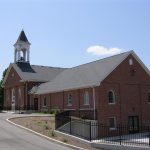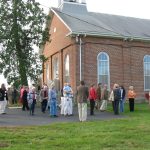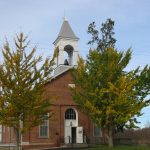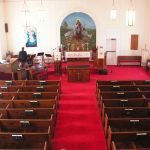CHURCH HISTORY
A Legacy of Faith: The Story of St. George Lutheran Church
St. George Lutheran Church has been a cornerstone of faith and community since its founding in 1838 by Reverend Abraham Miller, a dedicated preacher known as the “Father of Lutheranism” in the region. Originally gathering in a farmhouse, the congregation soon built its first frame church in 1844 on the present site, near a key toll road junction and adjacent to a historic cemetery. As the church grew, it played a pivotal role in forming the Union Synod and later became part of the Olive Branch Synod. In 1867, the congregation pledged $5,000 to construct the current brick sanctuary, complete with German-imported stained glass and a 600-pound bronze bell from Cincinnati’s Buckeye Foundry, which still rings today.
Through the years, St. George has faced challenges, including economic hardships during the Great Depression, but the unwavering faith of its members ensured its survival. In 1932, St. Paul’s Church in Mt. Auburn merged with St. George, strengthening the congregation. The church continued to evolve, introducing a formal liturgy, growing under dedicated pastors, and expanding its facilities with a new parsonage and additional land. By 1988, St. George became a founding member of the IN-KY Synod of the ELCA and remains actively engaged in its mission.
Today, St. George Lutheran Church stands as a testament to generations of faith, resilience, and commitment to God’s work. Rooted in history yet focused on the future, it continues to serve as a welcoming place of worship, community, and spiritual growth.
TIMELINE
1835: Abraham Miller was ordained as a Deacon in the Synod of Indiana, and spent his life
helping to organize Lutheran worship in Bartholomew, Johnson, and Shelby counties, preaching and teaching for 37 years without any formal compensation. He is regarded as the “Father of Lutheranism” in this area, helping to establish at least 8 churches in the 3 counties region.
1838: Abraham Miller was called by a group of Jackson Township farmers to form St. George’s congregation, from a group of local residents who had been meeting at George Warner’s farmhouse to conduct Sunday services. (Located about one half mile from the present church).
1844: A frame church building was erected on the present site, near the Toll Gate at the junction of north-south and east-west toll roads, and adjacent to the cemetery which was founded there about 1820.
1859: St. George’s influence was instrumental in the formation of the Union Synod, and was the site of its conventions in 1860, 1864, 1868, and 1869.
1863: A group of church members decided to separate and form St. Paul’s Church in Mt. Auburn, possibly preferring to have services conducted in German.
1867: The remaining members of St. George pledged $5000 to build a new church, and sold the original frame building to the Pleasant View Separate Baptist group, who moved it north to a site in Mt. Auburn.
1868: The present structure, built of bricks made on the site, with stained and etched glass windows imported from Germany, was completed by the purchase of a 600 lb. bronze bell from the Buckeye Foundry in Cincinnati, which is still in use.
1871: The Union synod was dissolved, and St. George’s minister became president of the new Indiana Synod. Shortly after, St. George’s left the Indiana Synod to become part of the Olive Branch Synod. The church continued to play an active role, hosting Synod conventions in 1875, 1883, 1892, 1900, and 1910.
1925-1932: The church fell on hard times, without a pastor of its own for this period, but served by supply pastors. During the depression, some members of the congregation doubted St. George’s ability to survive, but the faithful held on and came through, at times having to hold turkey suppers to pay the pastor.
1932: The congregation of St. Paul’s, Mt. Auburn, decided to close their church and rejoin St. George’s congregation. This is when it became St. George’s United Lutheran Church.
1932-1936: Pastor C. Robert Defenderfer received his first call from St. George’s, and being a young and enthusiastic pastor, made significant changes; introducing a formal liturgy for the first time, and establishing the lectern and pulpit in their present roles. His wife took over the task of directing the choir, and together they set the congregation firmly on its present course in the Lutheran tradition.
1953: Pastor James Kelley accepted a call in 1953 and the congregation began to grow again.
1959: A new parsonage was purchased in Edinburgh, the remaining six acres of land around the church and cemetery were purchased and cleared, and a basement under the original building was completed to provide kitchen and classroom space.
1963-1970: Pastor Leonard Koss, presided over the re-entry of the congregation into the life of the church at large, becoming active once again in the affairs of the IN-KY Synod of the L.C.A.
1988: St. George was a founding member of the newly organized IN-KY Synod of the E.L.C.A, and became active in the work of the Bloomington Conference. In the same year, the church celebrated its sesqui-centennial with a year long program of special events, culminating in an anniversary celebration on June 12th. This celebration was attended by a large number of visitors and friends, including Bishop Kempski, and eight of Abraham Miller’s descendants.
1995: On the dissolution of the Bloomington Conference, St. George elected to join the Indianapolis Conference of the IN-KY Synod of the E.L.C.A.






As a church, we rely entirely on donations and offerings to sustain our ministry, maintain our historic sanctuary, and support the programs that enrich lives within our congregation and beyond. Every contribution, no matter the size, plays a vital role in keeping our doors open, our mission strong, and our faith alive for future generations.
JOIN US!
SUNDAY SCHOOL: 9:00 AM
WORDSHIP AND HOLY COMMUNION: 10:00 AM
